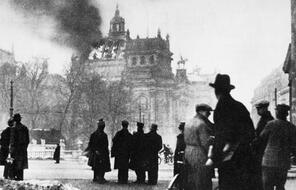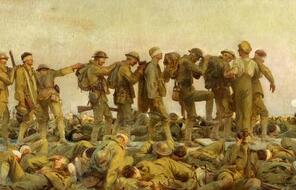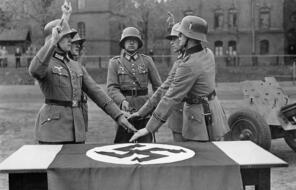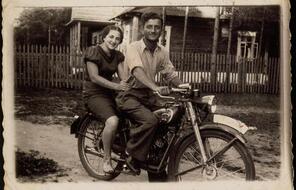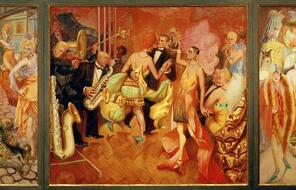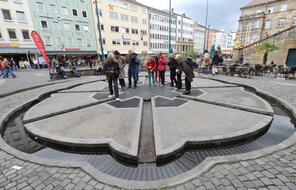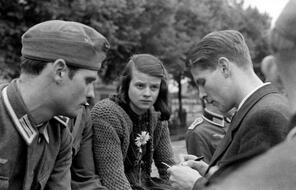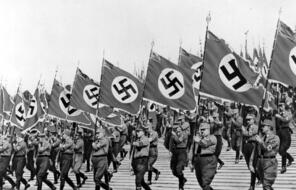Understanding Rescue: What Scholars Say
Subject
- History
Language
English — USUpdated
Historians and other scholars of the Holocaust use primary sources like the letters, memoirs, and testimonies featured on this website to understand what happened during this critical moment in history, and why. The question of why some people chose to defy Nazi laws and risk their lives to rescue others—sometimes neighbors, sometimes complete strangers—has fascinated scholars of this period and students of human behavior. Each instance of rescue was influenced by its own particular circumstances, including where it took place (in a city, in a rural area, in an area that was or was not occupied by the German army); when it took place (earlier or later in the war; over just one night or for a period of months or even years); the resources available to the rescuer and to those who sought help; and many other factors. Not all rescuers were successful, and because the penalties for aiding Jews were often so severe, we will never hear all the stories of those who tried to help but failed.
The many different stories of rescue raise pressing questions: What motivated rescuers? Is each rescuer unique, or are there certain qualities that many rescuers share? How can studying the choices of rescuers inform our own thinking and actions today?
In this section, we turn to the writings of historians, psychologists, and others to see how they have addressed these important issues. The authors featured in this segment offer different points of view. As you read, ask yourself: To what extent do these ideas connect to Martha and Waitstill’s story? How do they inform your understanding of the Sharps and their world?
After reading the scholar perspecitves, continue to the connection questions we suggest.
Cynthia Ozick
Cynthia Ozick is a short story writer, novelist, and essayist who has written frequently about the Holocaust. In the prologue to Gay Block and Malka Drucker’s book Rescuers: Portraits of Moral Courage in the Holocaust, she writes:
The neighbors are decent people—decent enough for ordinary purposes. They cannot be blamed for not being heroes. A hero—like a murderer—is an exception and (to be coarsely direct) a kind of social freak. No one ought to be expected to become a hero . . .1
For me, the rescuers are not the ordinary human article. Nothing would have been easier than for each and every one of them to have remained a bystander, like all those millions of their countrymen in the nations of Europe. It goes without saying that the bystanders, especially in the occupied lands, had troubles enough of their own, and hardly needed to go out of their way to acquire new burdens and frights. I do not—cannot—believe that human begins are, without explicit teaching, naturally or intrinsically altruistic. I do not believe, either, that they are naturally vicious, although they can be trained to be. The truth (as with most truths) seems to be somewhere in the middle: most people are born bystanders. The ordinary human article does not want to be disturbed by extremes of any kind—not by risks, or adventures, or unusual responsibility.
And those who undertook the risks, those whose bravery steeped them in perilous contingencies, those whose moral strength urged them into heart-stopping responsibility—what (despite their demurrals) are they really, if not the heroes of our battered world? What other name can they possibly merit? In the Europe of the most savage decade of the twentieth century, not to be a bystander was the choice of an infinitesimal few. These few are most substantial than the multitudes from whom they distinguished themselves; and it is from these undeniably heroic and principled few that we can learn the full resonance of civilization.2
Samuel and Pearl Oliner
In their book The Altruistic Personality, sociologsts Samuel and Pearl Oliner suggest that rescue was determined by circumstances and personal qualities.
Rescuers did not simply happen on opportunities for rescue; they actively created, sought or recognized them where others did not. Their participation was not determined by circumstances but by their own personal qualities. Chance sometimes provided rescuers . . . with an opportunity to help, but it was the values learned from their parents which prompted and sustained their involvement.
[The Oliners go on to describe Johan, a Dutch boy who was 17 years old when he became involved in rescue activities; they use his story to illustrate qualities that they believe characterize rescuers more broadly.]. . . Patriotism, law and order were among the first reasons Johan gave for helping Jews—values invoked by numerous groups, including those who have destroyed freedom and persecuted minorities. For Johan, however, these words had special meaning. For Johan, they were associated with freedom, justice, a fierce egalitarianism, caring for others, and a particular sense of obligation toward the needy and helpless . . .
Christianity was also a very important part of Johan’s life, but for him it meant primarily caring for the needy. Johan described his parents as very religious. As for himself, he went to church regularly in his youth and attended Bible classes, but he regarded these activities as largely duties. “I was not very religious when I was growing up,” he said . . .
In Johan’s view, love of country, law and order, politics and religion converged into fundamental ethical principles characterized by two strands: inclusiveness—a predisposition to regard all people as equals and to apply similar standards of right and wrong to them without regard for social status or ethnicity—and attachment—a belief in the value of personal relationships and caring for the needy. He credited both to his parental home. 3
Shlomo Breznitz
In one of the pieces featured in The Courage to Care, a collection of essays edited by Professor Carol Rittner, Israeli psychologist Shlomo Breznitz reflects on the meaning of courage:
Courage is never alone, for it has fear as its ever-present companion. An act deserves to be called courageous if, and only if, it is performed in spite of fear. The greater the fear, the more courageous the action that defies it. Thus, it is only when fear and anxiety rule supreme that courage can truly assert itself . . .
It is when fear dictates, “Run,” and the mind dictates, “Stay”; when the body dictates, “Don’t,” and the soul dictates, “Do,” that the heroic battle is being waged. At times, for an all-decisive split second, one musters the strength to force the issue; at other times, the difficult decision must be upheld for a long time against renewed attacks of fear and doubt . . .
A brave act, by definition, implies risk taking. The issue to consider is, for whose sake is the risk taken? Is it for the sake of the individual himself or herself, a close relative, a dear friend, or is it a commitment to one’s group or society? The more distant and intangible the cause, the greater the courage implied by the action.4
Connections
- Which of the scholars’ theories are most powerful to you? Which ones best explain the Sharps and their choices? Be sure to cite specific evidence that supports your opinion.
- Cynthia Ozick writes that rescuers are “not the ordinary human article,” explaining that their courage and altruism set them apart. But most rescuers themselves insist that what they did was “normal,” that “anyone would have done it.” How do you understand the difference between the rescuers’ descriptions of their actions and the analysis of scholars? Are rescuers ordinary or extraordinary?
- To date, 23,788 people who rescued Jews during the Holocaust have been honored as “Righteous Among the Nations” by Yad Vashem, Israel’s Holocaust memorial and museum. This number may seem large, but in fact rescuers were a tiny minority within a larger population of bystanders and perpetrators. Given that rescuers are such a small exception within the history of the Holocaust, why do they deserve the attention of students and scholars?
- Pierre Sauvage, a filmmaker and Holocaust survivor, has addressed this question. He says, “If we do not learn how it is possible to act under even the most trying of circumstances, we will increasingly doubt our ability to act under even less trying ones.”5
- You can learn about other rescuers during the Holocaust in the Facing History resource book Holocaust and Human Behavior. Some rescues were spontaneous; others were carefully planned. Some rescuers knew those they helped; others were strangers. What other patterns do you note among the stories of rescue? Is each rescuer unique, or are there certain qualities that many rescuers share? How do the Sharps fit in?
- Is it true that it takes “courage” to “care”? When and why can the simple act of caring be considered courageous? What kinds of courage were required of Martha and Waitstill Sharp?
- Many scholars of rescue focus on the idea of altruism. How would you define altruism? Think of examples of altruistic actions that you have seen or taken part in. What motivated those actions? What effects did they have?
- In his book The Abandonment of the Jews, historian David Wyman wonders, “Would the reaction be different today? Would Americans be more sensitive, less self-centered, more willing to make sacrifices, less afraid of differences now than they were then?” How would you answer Wyman’s question? What experiences, memories, and knowledge shape your response?
- The horror of the Holocaust led many people to vow that such a genocide would “never again” take place. Despite these promises, in today’s world, many governments still violate human rights, fail to protect their citizens, and even commit genocide. Many organizations and individuals work to provide aid, relief, and rescue in these troubled places at great personal risk. They include:
As you explore these contemporary stories, consider how the choices they’ve made echo the choices made be Martha and Waitstill Sharp. How are the opportunities and challenges of rescue and relief different today?
- Aid worker Carl Wilkens, the only American who chose to remain in Rwanda when other foreigners were evacuated during the 1994 genocide; he saved many Rwandans, including children at an orphanage.
- Australian Rebecca Hamilton, who traveled to the Darfur region of Sudan as a university student to do relief work. She became a leader of the student movement to end the genocide in Darfur and cofounded the Genocide Intervention Network.
- American Ryan Boyette, who resigned his position with an American aid organization after all staff were ordered to leave the dangerous Nuba Mountains region of southern Sudan. Boyette chose to remain to bear witness to the government’s atrocities in the region and spread the news to the world.
- Malka Drucker, coauthor of the book Rescuers: Portraits of Moral Courage in the Holocaust, believes that:
- Categorizing the rescuer can be misleading; it separates us from reality. We may prefer to believe that these people, examined collectively, possess incomprehensible heroism or goodness, because then we don’t have to speculate how we would behave in similar circumstances. Perhaps it is easier to acknowledge evil because we do not want to know that we have the same capacity for goodness.To understand these people as no different from us, possessing the same doubts, fears, and prejudices, raises the uncomfortable question, “Would I do what they did?”7
To what extent are the rescuers like us? What sets them apart? What questions has the study of rescue raised for you?
Endnotes
1 Cynthia Ozick, "Prologue" in Malka Drucker and Gay Block, Rescuers: Portraits of Moral Courage in the Holocaust, xii.
2 Ibid, xvi.
3 Samuel P. Oliner and Pearl M. Oliner, The Altruistic Personality: Rescuers of Jews in Nazi Europe (The Free Press, 1992), 142–144. Reprinted with permission from Samuel P. Oliner and Pearl M. Oliner.
4 Shlomo Breznitz, “The Courage to Care,” in Courage to Care, ed. C. Rittner and S. Myers, 149-151
5 “The Courage to Care,” in Courage to Care, ed. C. Rittner and S. Myers 135.
6 "Introduction," A Guide to "Rescuers of the Holocaust," 1.
7 Malka Drucker and Gay Block, Rescuers: Portraits of Moral Courage in the Holocaust, 6.
How to Cite This Reading
Facing History & Ourselves, “Understanding Rescue: What Scholars Say”, last updated February 26, 2021.


